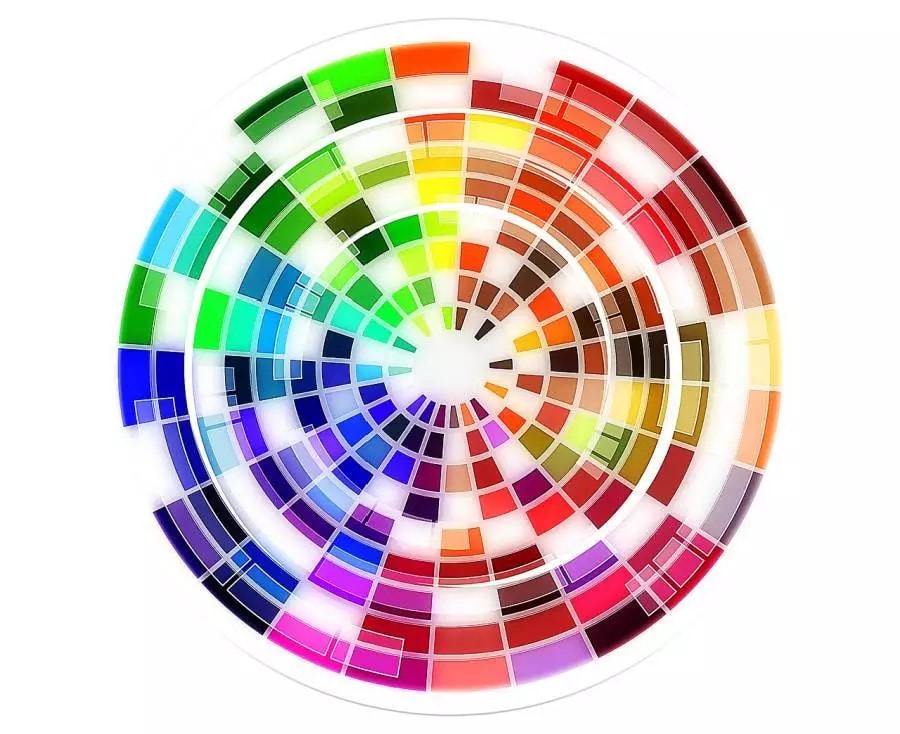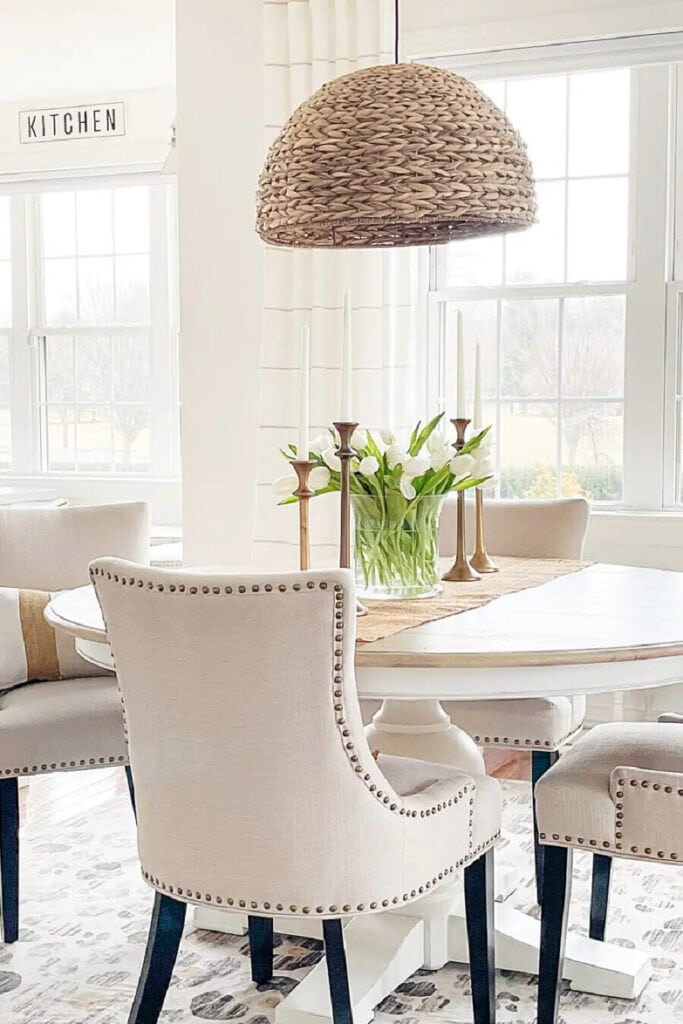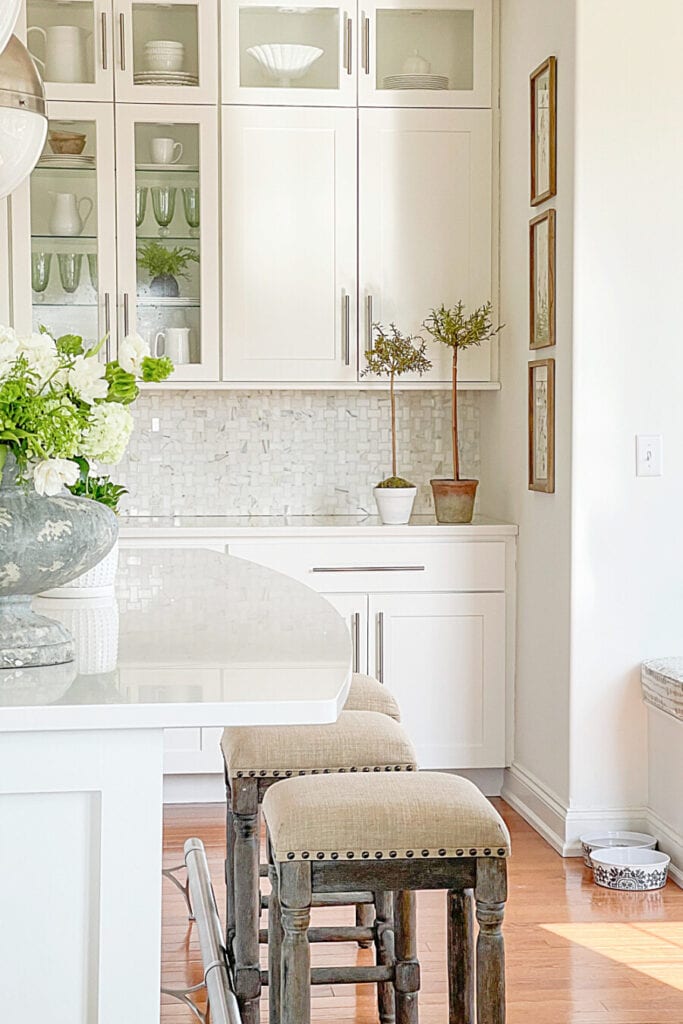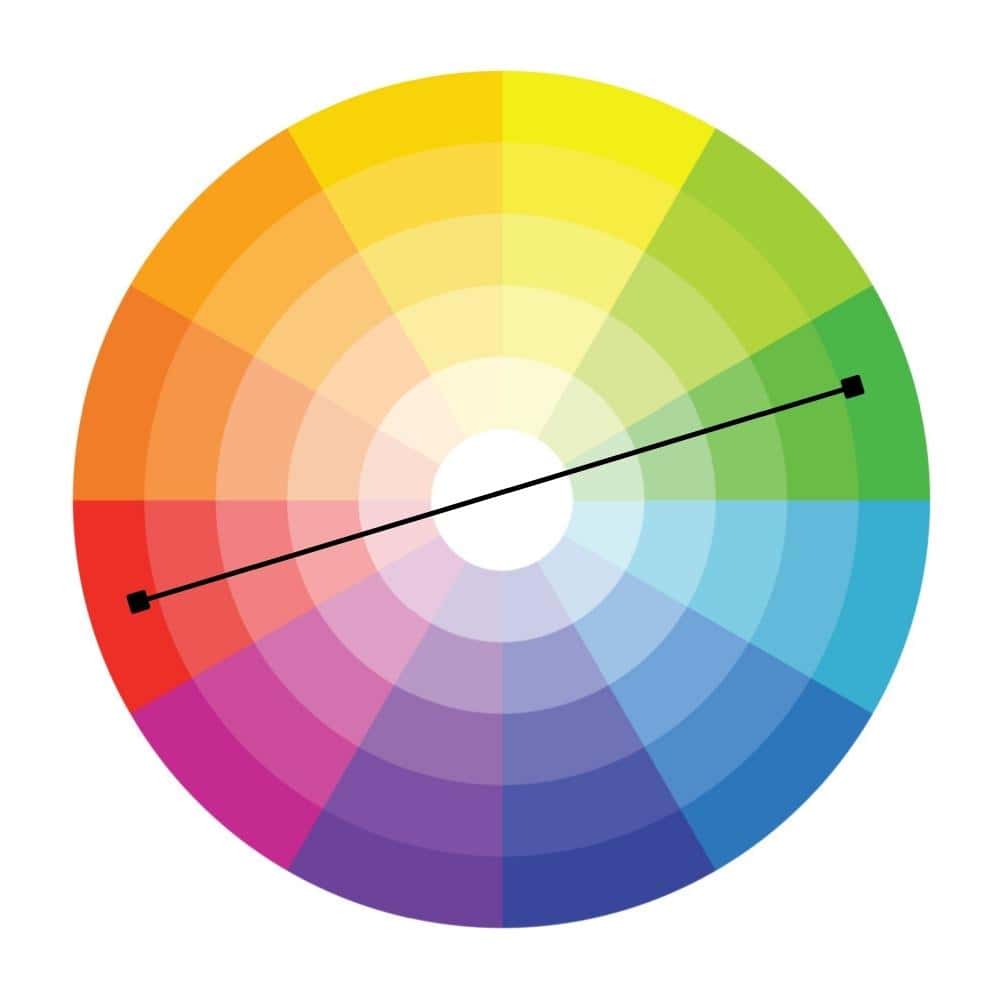How To Choose A Color Palette For Your Home
One of the best ways to create a beautiful, cohesive room is to choose and use a color palette. Let’s learn about what color palette is, why it creates harmony in a room or even your whole home and how to create the best one for you.
Today’s posts will be an AHA decorating moment! One of the easiest ways to make a room or even your whole home look “put together” and cohesive is to create, use and stick to a color palette. A color palette is a powerful home decor unifier!
Whether you want new colors for your living room, guest room, or your entire home this post will help you understand how to create a color palette using colors you love!
I must admit whole house color schemes are my favorite! If you can choose a color palette for one room you can choose a color palette for your whole home!
WHAT IS COLOR PALETTE
Basically, a color palette is the colors you choose and use to decorate your home. These colors should work together to bring beauty to your home.
There is a lot to know about creating the perfect color palette for your home.
WHY CHOOSE ONLY ONE COLOR PALETTE FOR A ROOM OR MY WHOLE HOUSE?
Oh, I love this question!
There are several reasons you should choose an overall color palette for a room or even your home.
Let’s talk, for just a minute about choosing a color palette for your whole home.
The two biggest reasons to choose one color palette for your home are
- the rooms in your home will flow seamlessly together.
- and because a whole home color palette makes decorating your home so much easier.
Here are a few more reasons for choosing a whole house color palette…
- a whole home color palette is easier than choosing different color palettes for different rooms
- items from one room can be used in another easily
- a color palette will make it easy to shop and find things for your home. No guessing if the color will work with what you already have
- you can change the ratio of colors from one room to the next to create interest
HOW DO I KNOW WHAT COLORS WORK TOGETHER?
This is a great question. Not all colors are friendly with one another and some actually fight! Some colors work together better than others.
Knowing what colors look the best together will create a pretty and no-fail color palette for your home. This will keep them all living and working together to create something special and beautiful!
It’s a good idea to learn a little about how to choose colors for an attractive color palette.
5 STEPS FOR CHOOSING A COLOR PALETTE
There are a few tried and true steps to choose colors for your home that will ensure a successful color outcome.
1). How do you want your home to feel?
Ask yourself how do you want your room or home to feel.
This may seem like an odd question, but it is the most important question to ask when beginning to choose colors for your home!
Color has a very big psychological pull on us.
Yellow makes us happy, blue makes us calm. Orange can make us energetic, brown can make us feel cozy, and gray can make us feel moody.
So knowing how you want your room to feel will can also tell you what colors will work best to develop that feeling!
Try to define how you want your home to feel by using adjectives to describe the vibe you want your home to give.
Here are some common house descriptions: warm, cozy, airy, moody, bright, happy, clean, relaxing, upscale, homey, and calm.
Try to think of how you want your home to feel. Then pick two words like warm and cozy or bright and airy or cozy and calm and create a color palette that helps make those adjectives come to life on the walls and rugs and furnishings in your home.
The words I chose to describe our home’s vibe were airy, calm, and bright. No wonder I chose a neutral color palette infused with lots of white and light neutrals.
2. Choose a color you love.
You can start to create a color palette by choosing a color you love. It’s that easy! Do you love a color in a painting or rug or even in a bunch of flowers you bring into your home?
Or is there a color of something in your home that you cannot remove? You might want to use that color as a jumping-off point for a color palette.
For example, let’s say your home has blue wall-to-wall carpeting in every room (except the bathrooms and kitchen), then you should start with this color because it will be a dominant color to consider when choosing a color palette.
Think about flooring, cabinetry, and other “fixed” items in your home.
Let’s call this your foundation color.
3. Using a color wheel find the colors that work best with your foundational color.
A color wheel is really your best friend when you want to choose the right colors for your home. And it is not hard to use.
Here are the four main types of color combinations you should be looking for when choosing a color palette for your home.
And below is a color wheel you can use. It has shades and tints of each color. This color wheel is broken down into primary (red, yellow, and blue), secondary ( orange, purple, and green), and tertiary colors ( blue-green, blue-violet, red-orange, red-violet, yellow-orange, and yellow violet).
Secondary colors are made by mixing the primary colors together. And tertiary colors are made by mixing primary colors and secondary colors together.
This is a wonderful chart to help you understand the colors on the color wheel.
I like this color wheel because it also adds some of the tints and tones of the colors as well!
Here are 4 different combinations of colors on the color wheel that will help create a great color palette for a room in your home.
Monochromatic Color Scheme: Using one color in different tints and tones of one shade (pure color). A tint is made by adding white to a shade and a tone is made by adding black to a shade. Another name from shade is tone.
For a monochromatic color scheme, you may want to use a few different shades or tints of the color you choose.
If you are color hesitant a room in a monochromatic color scheme with lots of white and a touch of black, gray, or other neutral can be beautiful.
An example of this would be green and all its tints and tones.
Or orange and all its tints and tones.
Analogous Color Scheme: This pretty color palette uses colors that are adjacent on the color wheel.
They create beautiful rooms that are harmonious. This is a very easy way to create a color palette. Use different tints and tones of these next-door neighbor colors.
To create an analogous color palette you can use two colors or up to five next to one another on the color wheel.
Complementary Color Scheme: Complementary colors are directly opposite on the color wheel. These opposite colors play off of one another to create a room with an energetic feel.
If you are a beginner to the world of color, a complementary color scheme is an easy and pretty one to use in a room.
Add white, and a little black to make the color palette look balanced.
Triad Color Scheme: This color scheme uses three colors that are evenly spaced out on the color wheel. These colors seem unexpected but when used in a room or whole house in varying percentages like 60% one color, 30 % another color, and 10% of the last color, you can create beautiful rooms.
You can use this color combination in different ways throughout your home for a varied look that still is cohesive.
There are several other types of color schemes used in interior design but these are the most popular and easiest to create a color palette.
You will want to find 5-7 colors you can mix and match in differing percentages for a whole home color palette.
And you will want to add black or brown and white into the mix. Other light neutrals might work as well.
4. Consider the UNDERTONES in the colors you choose.
If you have not read my post How To Mix Warm And Cool Colors make sure you do! It’s a must-read to understand how to pick a color palette for your home.
Most colors, except pure colors, have undertones.
Undertones are colors that lie under a color that change the main color. I like to think of them as hiding under a color. Hence, undertones.
Let’s look at the color green again to understand undertones a bit better.
Here is an easy example:

The center block is green. When yellow undertones are added to green it becomes a much different green. Almost a spring green. And when blue/ violet undertones are added to green it also becomes a different green. But this time, a more sage green.
Undertones of different shades and tints have huge effects on color! So knowing the undertones of a color you choose for a color palette in your home is important!
COOL AND WARM COLORS
When we talk about undertones we must also talk about warm and cool colors.
Let’s look at the color wheel again. All colors are either warm or cool. Except for pure white. And white is almost never pure! It usually has an undertone affecting it.

The color wheel is a complex device that organizes color in a wheel-type shape showing color relationships to each other.
For this post, I’m using the color wheel to illustrate two important things…
- the warm colors on the color wheel
- and the cool colors on the color wheel
The color wheel is basically broken down into warm and cool colors.
A great example in nature of a warm and cool color spectrum is a rainbow.

Warm colors are red, orange, and yellow. And cool colors are green, blue (indigo), and violet (purple).
Knowing whether the undertones in a color are cool or warm will help you pick colors that work together in a color palette.
The undertones in white, gray, and beige are often very tricky to find. So we will spend another time in another post talking about them.
However, you might like to read The Ultimate Guide For Choosing The Perfect White Paint Color. I talk a lot about undertones and have lots of inspiration for using and choosing the right paint.
Other topics covered in this relevant post are…
- white paint for a ceiling
- how to read paint chips
- how grey affects white
- the difference between warm white and cool white
- different paint sheens like flat, eggshell, semi-gloss, and more.
5. Use the 60-30-10 Rule
When thinking about using color in a room the 60-30-10 rule and all its variations are the gold standards.
Here’s how it works…
60% of a room should be decorated in one color. Usually the walls and other big foundational furnishings.
30% of a room should be decorated in another color. Think about using this color for draperies, bed linens, accent chairs, accent walls, and painted furniture.
And 10% is that wonderful accent colors used in throws, pillows, artwork, and decorative accessories.
This rule has many variations depending on your taste and decorating choices. You may like an 80-20 or a 70-20-5-5 or even a 90-5-5. It all depends on how you want to distribute color around your room.
For a monochromatic color scheme, you may want to use a few different shades or tints of the color you choose in a 60-30-10 distribution.
The main point of this rule is to choose colors in varying degrees in a room. Use one or two colors for most of the room and then the rest of the colors in small amounts to add personality and fun to a room.
When the percentage of all the colors in your color palette is equally distributed around a room, that room can look boring and uninspiring!
OUR HOME’S COLOR PALETTE
Our home’s color palette is very neutral. Lots of whites, beige, caramel, warm brown, gold, and a little bit of soft, gray. The color palette is warm, even though our walls are white.
It is primarily a monochromatic color palette. Here are the neutral colors in our home…
A lot of white and a tiny bit of black are added to the color palette! I also like to add a pop of color that gives a nod to the season too.
It’s important to physically create a color palette and not just create a color palette in your mind! Have a tangible color palette just like you should have swatches of the paint and fabrics you use in a room. Having all these will lead to success!
LAST THOUGHTS ABOUT CHOOSING A COLOR PALETTE FOR YOUR HOME
A color palette should make decorating more manageable and not harder. It should be a guide to help you choose everything that goes into a room. And if you are working on a whole home color palette you should be able to move furnishings and accents from one room to the other with ease! Sounds wonderful, doesn’t it?
If you are like me, you have been through quite a few color palettes throughout the years! So you should never feel stuck with colors in your home you have grown out of or look dated and tired to you!
Changing a color palette takes time and is a process. But is so worthwhile. Be brave and find a color palette you love.
I hope you have learned a lot about choosing the perfect color palette for your home!
My final word is…Live with colors that inspire YOU!
You might like these other decorating posts…
8 THINGS YOU SHOULD KNOW ABOUT COLOR
















I just had an ah ha moment! By painting the home all one color, I just simplified my life! My office is a soft peach color, the half bathroom is a sage green and the living room and dining room are a soft griege (husky gray by Benjamin Moore which I absolutely love). The office and half bathroom feels off and now I know why! I am getting my paint brush out today to start changing the color. Now my decorating ideas for the rooms have become very clear. Thanks you! Wow!
Yay! You are so right! Paining your rooms the same color will look so more cohesive!
This was a very interesting and informative article. It was a good read and it was nice to see diagrams added in. However, I found it quite disappointing that almost all of the photos that were shown in regards to examples of interiors were white with white and a little more white on top of that. Where was the visual examples of actual color rooms using the teachings of complimentary and contrast schemes?
Sorry! My home is very neutral so images with white and neutral colors are all I have. I’m sure you can find lots of examples on Pinterest.
My Family room has a large brick fireplace. The brick is the a rusty red brick with splashes of black and gray. It looks like someone literally threw splashes of these colors at the brick. The brick wall takes up three quarters of a major wall. My furniture is a mixture of browns some with cool tones and others with a warmer tone.We are going to be changing the flooring and are trying to find a wood vinyl that goes with the dining room which has Teak hardwood flooring. The brick wall is so massive it makes it hard to decorate the mantel and have anything show up. We are open to painting the brick but are not interested in white or a dark color as the room is pretty dark anyway. Any suggestions?
Hi Debi, you might think about a cream or greige or other neutral colors with the same undertones as your flooring and furniture. Hope this helps.
A problem that probably a lot of us has is how do you make the transition from one color pallet to another? After surviving the avocado, then earth tones, then jewel tones over the years all of our furniture pieces are neutrals, with either a soft yellow or a creamy white wall color, and all my draperies are creamy white lined sheers. The first thing I did was paint our front door in a color that sets the tone for the interior – in our case a French blue. Then we purchased a beautiful area rug for our family room in soft blues, creams, etc. New pillows in the family room are blues and creams. Our foyer also sets the tone for the rest of the house with a transitional piece of artwork with all the colors I am transitioning to. The only problem is this has taken several years, and I am still not quite happy with everything. I guess it’s a process. I guess you start with the basics and then go from there. It’s expensive to transition and takes time. I would suggest to any new homeowners to remember to start slow and select pieces of furniture that are neutral, or whatever color you love, and go from there. The other thing I find to be a problem when making a color transition is you have to remove any of your old colored accessories when you start adding new items. In today’s world there are bigger problems to think about, but our home remains our safe place, and we all want it to be a reflection of the people that live there. I think a great subject for Yvonne is a tutorial of how a young homeowner should start the process of home ownership.
You are a wealth of great advice and tips, Lyn! You are so right! And thanks for the suggestion!
Super ideas, Lyn!
My home is very similar in color way to your’s but I picked a dark bronze instead of black. A “touch of black” seemed too harsh with my creams and taupes. I carried the paint color throughout and for the most part the same in both hard and soft finishes. In my bigger guest room, I did deviate as I had bedding in a lovely big floral that I stilled loved and two wing chairs in a blue & linen check. I kept the chairs & throw pillows but went with white curtains, white sheets and a linen mattelise cover. It’s a charming room that harks back to my bigger more traditional house.
I love your lessons Yvonne. They are I depth and must take quite a bit of time and research to put together so I wanted to say Thank You!
Hi Joanna, thanks for recognizing the time (and love) I put into each post. Your color palette sounds lovely!
Enjoyed …loved the color wheel! Enjoy clean fresh white…however, live in the country where the dust blows! I also love color…bright pops of color!
I absolutely love the new rug in your sunroom. Could you please share info about it?
I look so forward to getting your posts. They are an inspiration to me!
Hi Sharon, I found it on erugsales.com
I just finished reading two of your articles. The first is decorating with warm and cool colors and how to pick a color palette. I enjoyed both of them. They are very easy to understand and informative. I have been trying to figure out this for a while now. Unfortunately I am not sure if I am on the right path. I have golden oak cabinets and golden oak fire place mantel with bricks that have dark gray, light gray, some brown, and burnt orange colors. I am not able to change these at this time. I also, have oak flooring and black iron stair railing. I chose SW Conservative gray paint color for living area, foyer, kitchen, hallways. I have a dark charcoal couch and 2 light gray chairs as well as a brown club chair. I love the paint color, but do not know which direction to go next or if I have totally gone in the wrong direction. I would love to hear your thoughts.
Hi Carolyn, I won’t be able to give you my opinion unless I see pictures. Can you email me pictures of your home? Send them to stonegable333@gmail.com
I might not answer right away. I have a house full of family this Thanksgiving weekend.
when painting the fireplace bricks, choose a darker color than your walls, a bronze brown color. also paint the golden oak mantle darker than the brick color… deleting a lot of the golden oak will make the colors of the room pop. ramp up the sofa and brown chair with throws and pillows that bring in happy colors.. painting the fireplace bricks will ground the room with weight. happy decor
Yvonne – in your post you showed 6 circles with paint colors that you feature in your home. Could you possibly post the names of those six colors. Thanks for the wonderful post.
These splotches are not any certain color. They are there to help you see the differences in color and undertone.
These are not any certain colors, like wall colors, but the colors I use in my home.
I so appreciate your articles and your wisdom that you share!
I do have a question though… I have a number of houseplants in my windows – both hanging as well as on the sill. Should I be including the green of the plants in my colour palette for the room?
I love plants too! Green from plants is considered free. Don’t include green unless you want to use it in other ways in a room.
Oh thank goodness! I love my plants but definitely don’t want dark green included in a colour palette for a room!
Thank you so much for your help!
Happy Palm Sunday!
Carolyn
Super ideas, Lyn!